Vintage Report: Burgundy 2021 by Matthew Hemming MW
Our first thoughts on the new vintage, tasted in the Cote d'Or late last year.

Our first thoughts on the new vintage, tasted in the Cote d'Or late last year.
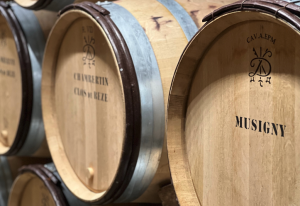
Tasting Burgundy’s 2021 vintage I found some terrific wines in both colours. In fact, the more I think about it, the more I realise I am really quite smitten by 2021 – these are precisely the styles of wine I seek out.
As a Burgundy lover, 2021 is a vintage I want to buy, cellar, drink and share. As a wine merchant, I believe customers are going to really enjoy the wines over many years and I am excited to sell them. The problem is, there is very little wine to go around.
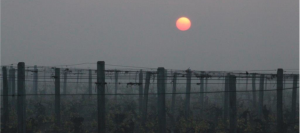
Cast your mind back 18 months and you may recall the news reports of spring frosts so acute they posed a severe threat to European agriculture. So devastating were the frosts in France it was reported as a National Emergency.
April’s spring frost savaged the Cote d’Or. We spoke to producers, such as Domaine de la Folie, who lost up to 85% of their crop. Such were the losses that there are wines producers were simply unable to produce in 2021: there is no Montrachet from Jean-Michel Chartron and Henri Gaunoux has not made any of his usual negociant wines.
Global warming has shifted the vines’ growth cycle forward; critical stages of development now regularly take place earlier in the year than was once the norm. After a particularly mild spring in 2021 the plants were advanced and particularly vulnerable to the frost. Unusually, rather than settling at the foot of the cote, home to lesser village and regional Bourgogne vineyards, the frost hit the mid-slope sweet spot of 1er- and Grand- Crus.
To add insult to injury, bright and clear mornings saw brilliant sunshine refracted and magnified through the ice crystals, scorching the delicate buds and finishing the job. As a final twist of the knife the spring and summer weather was somewhere between cool and lousy, delivering the first genuinely cool climate Burgundy vintage since perhaps 2014 or 2008.
In broad terms the white wine domaines of the Cote de Beaune were worst hit, as Chardonnay is more precocious than Pinot Noir and the vines were more advanced. Domaine Chavy-Chouet, in Meursault, lost about 70% of their crop, for example. It is not true that red wine estates escaped damage, however. In Gevrey Chambertin, Domaine Rossignol-Trapet lost about 30% across their range and, in Marsannay, Bernard Bouvier told us he was down approximately 65%.
The April frosts are the shadow looming over the 2021 vintage; the quality and charm of the wines born out of such adversity merely add a bitter-sweet quality to the story. However, nature did not stop at the frost. Perfect conditions for mildew followed, further decimating the surviving fruit. At the point of harvest, growers who must have been exhausted by the challenges of such a year, were faced having to sort their fruit forensically and discard berries compromised by rot. It must have been beyond dispiriting.
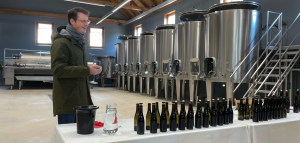
At Domaine Dujac, Jeremy Seysses presented the wines to a couple of dozen invited importers, critics and sommeliers (pictured above). The presentation was in French, and mine is not so good, but I did note Jeremy using the phrase ‘retro millesime’. This chimed with how I had heard a few growers describe 2021, as a vintage from another era. Following a succession of sun-kissed, solar years, 2021 saw growers actively chasing ripeness rather than trying to ameliorate it. Fighting for ripe fruit would be more familiar to the parents of the current generation of vignerons than those making the wines today.
2021 is not entirely old fashioned, however. It might be a retro style vintage but it has been realised using the best of modern viticultural techniques and winemaking practices. To my mind the sensitivity and ability to adapt to the vintage conditions were crucial to making successful wines in 2021. In all probability, not many years ago, 2021 would have been all but a total write-off.
Acidity is a feature of 2021 Burgundy. For white wines this means a degree of structure that many of the old guard had begun to fear had disappeared from Burgundian Chardonnay forever. The wines are mineral, driving and taut. They ripple with electricity – more so than 2017, maybe more than 2014, so what becomes the reference point after that? 2007? 2004? So many of those have fallen prey to premature oxidation – but here’s the thing: 2021 tempts me to age white Burgundy once again. Of course, there is no shortage of junior wine for hors classe early drinking but, with the work done by conscientious growers, the widespread adaptation of Diam 30 technical corks and the developments in QA procedures for high quality natural cork, cellaring 1er- and Grand- Cru whites is once again becoming a viable and tempting option.
Few 2021 reds are deeply coloured, once again recalling wines of the past. Put a 2021 next to a glass of 2018 and the colour difference alone would be striking; the next contrast that would hit you would be the difference in alcohol! 2021 reds are rarely dark-fruited, rarely powerful and I struggle to think of many I would describe as muscular – de Vogue’s Bonnes Mares being a rare exception. Instead, I found the reds slender and willowy, scented and fine.
In general 2021 saw less whole bunch fermentation that in some years, as producers were concerned about the ripeness of the stems and did not want to risk leaching green tannins into their wines. Others, though, used stems to moderate the acidity of 2021 – stems bringing additional potassium that actually increases pH (reducing the intensity of acidity).
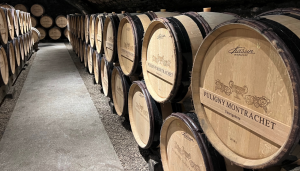
In both colours I was seriously charmed by a series of wines from Pernand Vergelesses. You would not have to go back too many years to find Pernand a source of green, under-ripe and frequently scrawny wines. Today, it is home to great value, zippy and mineral whites and red-fruited, lithe and perfumed reds.
A new (to us) name is Domaine Philippe Bouzereau, whose family of extended cousins seem to own most of Meursault. Based in the grounds of the Chateau de Citeaux, in an impressive new winery, Philippe and his brother make wines with whistle-clean lines and great precision. From Bourgogne upwards, this is a name to watch.
Staying in Meursault, 2021 feels like a break-through vintage for Romaric Chavy, whose barrel cellar is pictured above. When I first visited Chavy-Chouet I thought the wines were soft, pretty and made for attractive early drinking. Romaric has upped the ante by multiple notches and hits an entirely new level with 2021. Linear, citric and blossom-scented, I found something Roulot-esque about this range. Chavy-Chouet has become a very serious address and is approaching the upper echelons of quality in Meursault.
My favourite white wine tasting was at Domaine Jean Chartron. Jean-Michel’s vines were hit hard by the frost – his Puligny Montrachet 1er Cru Vieilles Vignes is 100% from Blagny in 2021 as the other 1er Cru sources were 100% wiped out and there is no Montrachet whatsoever. The 2021 village Chassagne Montrachet is interesting as Jean-Michel included young vine fruit from his recently re-planted 1er Cru Cailleret in the blend. Batard Montrachet is also a stand out, although our total allocation is only 24 bottles. Normally Jean-Michel supplements his domaine production with purchased barrels but, this year, he only has 1.5 barrels of his own production and it is glorious!
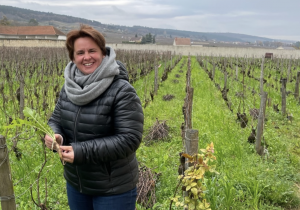
If the quality of village-level wine is a good indicator of the performance of that village, then 2021 was very successful in Gevrey. Of course, this might be something to do with the quality of estates in Gevrey but Rossignol-Trapet’s Vieilles Vignes, Heresztyn-Mazzini’s Les Jouises and Caroline Drouhin’s En Combes, at Drouhin-Laroze, make a strong case for the village’s superior performance in 2021. The photo above shows Florence Heresztyn-Mazzini in her Clos Village vineyard, whose 70 year old vines produced a notably delicate and fine-spun village Gevrey.
For value in red Burgundy, domaines Follin-Arbelet and Rene Bouvier fielded some strong contenders. Simon Follin poured a bright and succulent sample of Aloxe Corton 1er Cru Les Vercots with seamless tannin, great clarity and definition. His father, Franck, then followed this with a rare bottle of the 1993 from the family’s cellar – compelling proof of the Cru’s underlying quality and ageing potential. Bernard Bouvier’s wines were recommended to us a couple of years ago by one of the team at Leroy, no less. The regime of circa 50% whole bunches and 30% new oak is the same throughout the range, meaning the distinction between specific terroirs is thrown into stark relief as the only varying factor. Here the Marsannay blanc Le Clos – a monopole of the domaine – and Marsannay Clos du Roy were particularly fine, alongside Gevrey Racine du Temps which is made from extremely old vines, and an imperious Charmes Chambertin.
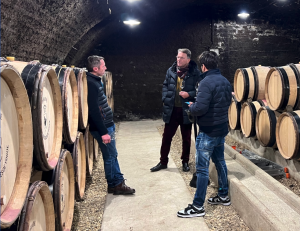
Tasting at the most prestigious domaines is always a treat even if the wines have no need of our notes to find buyers. It will continue to be fascinating to follow evolutions at Comte Georges de Vogue as new winemaker Jean Lupatelli establishes himself – Jean is on the left of the picture above, in discussion with Jean-Luc Pepin and Singapore sales director Timothy Goh. Two things stood out at Vogue this year: the introduction of a small proportion of whole bunch fermentation for the reds and my first ever taste of Musigny Blanc from barrel – previously this was never offered! There are only two barrels of Chambolle Musigny 1er Cru in 2021 – which, right now, is officially Musigny Grand Cru because it is only declassified at the point of bottling – but buy some if you can. It’s superb.
Our tasting at Dujac was a high point, the quality of the 27 wines we tried distracting us from how cold it was sat in the vat room in December! My pick of the 2021 Grand Crus was Clos St Denis, with 95-97pts. However, it is worth noting that I gave precisely the same score to the Clos St Denis of Heresztyn-Mazzini tasted the previous morning. Both are the fruit of old vines and both use a high proportion of whole bunches; one will be much easier to buy than the other! The other Dujac to look for in 2021 is a stunning Vosne Beaux Monts that I preferred to Malconsorts, Echezeaux or even Clos de la Roche.
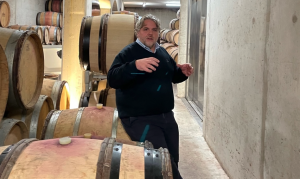
Above, Thibault Liger-Belair guides us through his 2021s.
2021 Burgundy is not so much a vintage born out of adversity as born out of disaster. You do not have to read between the lines of what I have written to understand that allocations will be more hard fought than ever, or that prices will be going up.
It would be all too easy to become downbeat about the challenges of 2021 and its pitifully small volumes but I hope my report communicates some of the very genuine excitement of the wines. I am convinced that this will become a very rewarding vintage for Burgundy lovers to have in their collections to follow and share. I look forward to buying a few of my long-standing favourites and I think we will look back at 2021 as a very special year for the wines of the Cote d’Or.